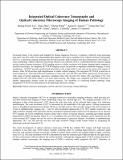Integrated Optical Coherence Tomography and Optical Coherence Microscopy Imaging of Human Pathology
Author(s)
Lee, Hsiang-Chieh; Zhou, Chao; Wang, Yihong; Aguirre, Aaron Dominic; Tsai, Tsung-Han; Cohen, David W.; Connolly, James L.; Fujimoto, James G.; ... Show more Show less
DownloadLee-2010-Integrated optical coherence.pdf (9.496Mb)
PUBLISHER_POLICY
Publisher Policy
Article is made available in accordance with the publisher's policy and may be subject to US copyright law. Please refer to the publisher's site for terms of use.
Terms of use
Metadata
Show full item recordAbstract
Excisional biopsy is the current gold standard for disease diagnosis; however, it requires a relatively long processing time and it may also suffer from unacceptable false negative rates due to sampling errors. Optical coherence tomography (OCT) is a promising imaging technique that provide real-time, high resolution and three-dimensional (3D) images of tissue morphology. Optical coherence microscopy (OCM) is an extension of OCT, combining both the coherence gating and the confocal gating techniques. OCM imaging achieves cellular resolution with deeper imaging depth compared to confocal microscopy. An integrated OCT/OCM imaging system can provide co-registered multiscale imaging of tissue morphology. 3D-OCT provides architectural information with a large field of view and can be used to find regions of interest; while OCM provides high magnification to enable cellular imaging. The integrated OCT/OCM system has an axial resolution of <4um and transverse resolutions of 14um and <2um for OCT and OCM, respectively. In this study, a wide range of human pathologic specimens, including colon (58), thyroid (43), breast (34), and kidney (19), were imaged with OCT and OCM within 2 to 6 hours after excision. The images were compared with H & E histology to identify characteristic features useful for disease diagnosis. The feasibility of visualizing human pathology using integrated OCT/OCM was demonstrated in the pathology laboratory settings.
Date issued
2010-02Department
Harvard University--MIT Division of Health Sciences and Technology; Massachusetts Institute of Technology. Department of Electrical Engineering and Computer Science; Massachusetts Institute of Technology. Research Laboratory of ElectronicsJournal
Proceedings of SPIE--the International Society for Optical Engineering; v.7570
Publisher
SPIE
Citation
Lee, Hsiang-Chieh et al. “Integrated optical coherence tomography and optical coherence microscopy imaging of human pathology.” Three-Dimensional and Multidimensional Microscopy: Image Acquisition and Processing XVII. Ed. Jose-Angel Conchello et al. San Francisco, California, USA: SPIE, 2010. 75700J-8.
©2010 COPYRIGHT SPIE--The International Society for Optical Engineering.
Version: Final published version
ISSN
0277-786X
Keywords
Optical coherence tomography, optical coherence microscopy, human pathology